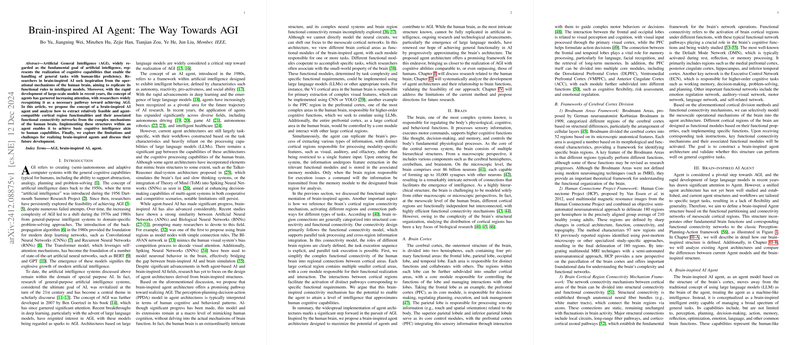Brain-Inspired AI Agent: The Path Towards AGI
Recent advancements in AI have brought researchers closer to the development of AGI, defined as AI with the ability to perform any cognitive task as well as, or better than, humans. The paper "Brain-inspired AI Agent: The Way Towards AGI" proposes an innovative brain-inspired AI agent architecture aimed at emulating the complex neural mechanisms inherent in the human brain, which may pave the way towards achieving AGI.
Summary and Analysis
The paper focuses on combining insights from neuroscience with AI, drawing parallels between the functional organization of the human brain and potential architectural configurations of AI agents. The authors propose a distinctive brain-inspired agent architecture that diverges from traditional models that often rely heaving on LLMs as central processing units. Instead, this architecture leverages the mesoscale operational principles found in the human brain, utilizing cortical regions as distinct functional modules within AI agents.
Key Components and Architecture
- Functional Modules: The brain-inspired AI agent is constructed using modules organized to mimic specific cortical areas responsible for various cognitive tasks such as perception, planning, decision-making, and memory. For example, functionalities like vision processing are implemented using models akin to the brain's V1 cortical area, while high-level cognition tasks invoke structures resembling the prefrontal cortex.
- Functional Connectivity: The architecture emphasizes the importance of functional connectivity, analogous to the brain's connectivity networks. It discards static structural constraints and adopts dynamic task-specific network activations, allowing parallel processing and efficient task execution. This mimics the brain’s facility for complex task management and fluid information processing across different regions.
- Cortex Division Frameworks: The use of established neuroscience frameworks like Brodmann Areas and the Human Connectome Project's regional definitions informs the architecture's design. The roles of key areas in higher cognitive functions are abstracted and mapped directly onto modular AI architectures.
Implications and Observations
The implications of this research are multifaceted. On a theoretical level, it highlights the potential of brain-inspired architectures to advance the field of artificial intelligence toward a more generalized cognitive capability. Practically, this could lead to significant breakthroughs across various applications, from healthcare to autonomous systems, where human-level intelligence is sought.
The proposed architecture also addresses some limitations in current AI research, including the task-specific nature of existing agent architectures. By aligning AI structural designs more closely with human brain principles, it proposes a pathway that could bridge the gap between current AI capabilities and true AGI.
Challenges and Future Directions
Despite its promising framework, achieving a fully brain-inspired AI agent is met with several challenges:
- Incomplete Brain Understanding: Current neuroscience provides an incomplete map of the brain’s complexities, leaving any AI endeavor to mimic it necessarily partial or speculative.
- Complex Integration: The integration of numerous functional modules and connectivity pathways within a cohesive system presents formidable implementation challenges.
- Resource Intensity: The potential computational resource requirements for such brain-mimicking systems could be prohibitive, requiring innovations in resource allocation and hardware design.
Future research should focus on further clarifying the intricate workings of the human brain, enhancing computational models of these processes, and refining the integration frameworks for AI architectures. Collaborations between neuroscience and AI fields, alongside continued technological advances, may eventually reveal approaches to overcome these constraints.
Conclusion
The paper presents a valuable contribution to the ongoing dialogue surrounding AGI and the applicability of brain-inspired principles in AI design. By proposing an agent architecture that models the human brain's mesoscale structures and connectivity, it offers a compelling vision for future AI systems capable of approaching human cognitive abilities. Successful implementation of this vision will likely transform the landscape of AI research and applications, possibly setting a new paradigm in the pursuit of AGI.
